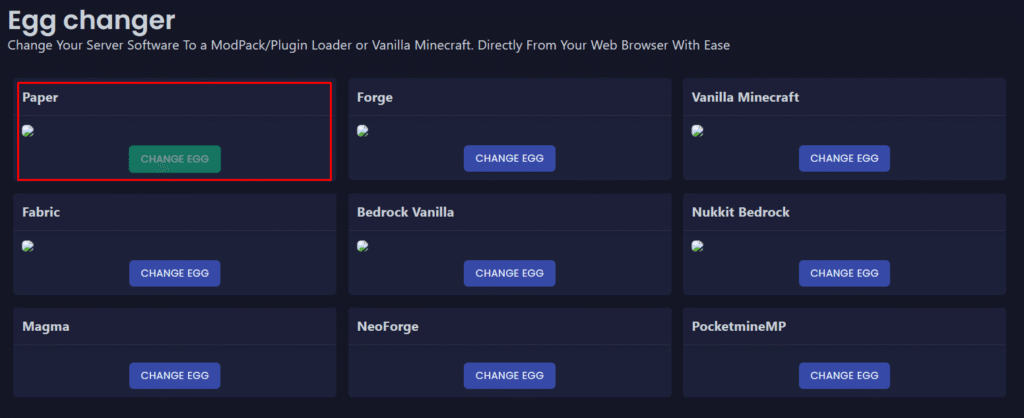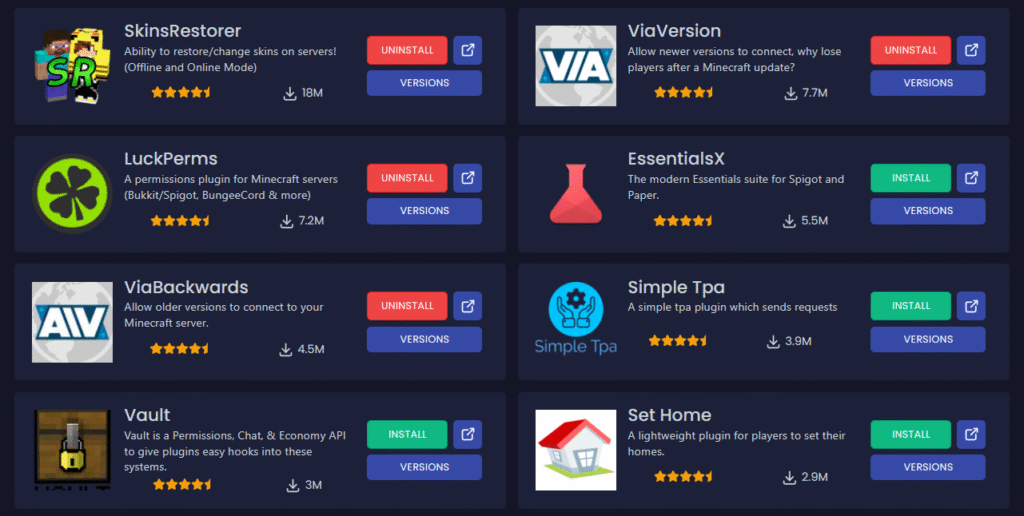Plugins are like add-ons for your Minecraft server that let you customize how it works. For example, you can add plugins to protect your server from griefers, create fun mini-games, or even set up a virtual shop where players can trade items. I remember when I first started my server, it was pretty basic just a few friends building together. But once I added plugins like EssentialsX and WorldGuard, it felt like a whole new game!
Plugins only work on specific types of Minecraft servers, like those running Spigot or Paper. They don’t work on vanilla Minecraft servers or Bedrock Edition. If you’re new to this, don’t worry—I’ll guide you through everything, including how to set up the right server software. By the end of this guide, you’ll know exactly how to install plugins and make your server stand out.
Why Should You Use Plugins?
Plugins make your server unique and fun. They can add features like:
- Protection: Stop griefers from destroying builds.
- Economy: Create a virtual currency for trading.
- Fun Commands: Add commands like /fly or /heal.
- Mini-Games: Set up games like SkyWars or Spleef.
When I added a plugin called LuckPerms to my server, it let me create ranks like “VIP” or “Admin,” which made managing players so much easier. Plugins also keep players coming back because they make the server more interactive.
1. Choose the Right Server Software

To use plugins, your server needs to run software like Spigot, Paper, or CraftBukkit. These are modified versions of Minecraft that support plugins. I recommend Paper because it’s fast, stable, and gets regular updates. When I first set up my server, I used Spigot, but I switched to Paper after noticing better performance, especially with lots of players online.
First, check if your server is already running one of these. If you’re using a hosting service like Apex Hosting or Shockbyte, they usually let you select Paper or Spigot when you set up your server. If you’re running a server on your own computer, you’ll need to download Paper from their official website (papermc.io). Make sure to pick the version that matches your Minecraft version (like 1.20.4 as of May 2025).
To install Paper, download the .jar file and place it in a folder on your computer. Then, create a start.bat file (on Windows) or start.sh file (on Mac/Linux) to run the server. This step is crucial because plugins won’t work on a vanilla Minecraft server. If you’re not sure which version to use, check what your players are using by asking them or looking at the Minecraft launcher. Once you’ve got Paper set up, you’re ready to move on.
2. Set Up Your Server
Now that you have the right software, it’s time to set up your server. If you’re using a hosting service, this part is easy they usually have a control panel where you can start your server. If you’re running it on your computer, you’ll need to do a bit more work. I remember setting up my first server on my old laptop, and it was a bit tricky at first, but once I got it running, it was so worth it!
To set up a Paper server, double-click the Paper .jar file or run your start.bat/start.sh script. The first time you run it, it’ll create some folders and files, like “plugins,” “world,” and “server.properties.” You’ll need to agree to the Minecraft EULA by opening the eula.txt file and changing “false” to “true.” Then, restart the server.
Next, test your server by launching Minecraft, selecting “Multiplayer,” and adding your server’s IP address. If you’re hosting locally, the IP is usually “localhost” or “127.0.0.1.” If you’re using a hosting service, they’ll give you the IP. Once you can join the server, you’re ready to add plugins. Make sure your server is running smoothly before moving on, as a stable server is key to a good plugin experience.
3. Find and Download Plugins

Finding good plugins is one of the most exciting parts of running a server! There are tons of plugins out there, and I’ve spent hours browsing sites like SpigotMC.org and Bukkit.org to find the best ones. For beginners, I suggest starting with popular plugins like EssentialsX (for basic commands), WorldGuard (for protection), and LuckPerms (for permissions).
To download a plugin, visit a trusted website like SpigotMC.org or dev.bukkit.org. Search for the plugin you want, and make sure it’s compatible with your server’s Minecraft version. For example, if you’re running Paper 1.20.4, check the plugin’s page to confirm it supports that version. Click the “Download” button to get the plugin’s .jar file.
A quick tip from my experience: always read the plugin’s documentation or reviews before downloading. Some plugins need other plugins to work (called dependencies), and the description will tell you what you need. Also, avoid downloading plugins from sketchy websites, as they might contain malware. Stick to well-known sources to keep your server safe. Once you’ve downloaded a few plugins, you’re ready to install them on your server.
4. Install Plugins on Your Server
Installing plugins is super simple, but you need to do it carefully to avoid errors. First, stop your server by typing “stop” in the server console or clicking the stop button in your hosting control panel. I learned this the hard way—trying to add plugins while the server is running can cause crashes!
Next, locate your server’s “plugins” folder. If you’re running the server on your computer, this folder is in the same directory as your Paper .jar file. If you’re using a hosting service, you can usually access the plugins folder through the file manager in the control panel or via FTP (using a program like FileZilla). Copy the .jar files you downloaded into the plugins folder.
After adding the plugins, restart your server. The server will load the plugins, and you might see some messages in the console about them starting up. To check if a plugin is working, join your server and try a command from the plugin (like /help for EssentialsX). If the command works, congrats—you’ve installed your first plugin! If not, check the console for error messages or make sure the plugin is compatible with your server version.
5. Configure Your Plugins

Most plugins need some configuration to work the way you want. This is where you can customize things like permissions, commands, or settings. When I first installed WorldGuard, I spent a whole afternoon tweaking it to protect my spawn area, and it was so satisfying to see it work perfectly.
To configure a plugin, go to the “plugins” folder and look for a subfolder with the plugin’s name (like “Essentials” or “LuckPerms”). Inside, you’ll usually find a config.yml file or similar. Open this file with a text editor like Notepad or VS Code. The file will have settings you can change, like enabling certain features or setting up ranks.
For example, with LuckPerms, you can create groups like “Member” or “Admin” and assign permissions to them. The plugin’s documentation (usually on its SpigotMC or Bukkit page) will explain what each setting does. Make small changes, save the file, and then run the “/reload” command in-game or restart your server to apply them. Be careful—typos in config files can cause errors, so double-check your work. If you’re stuck, most plugins have Discord communities or forums where you can ask for help.
6. Test and Troubleshoot
Testing your plugins is super important to make sure everything works smoothly. When I added a new plugin to my server, I always tested it with a friend to see if it caused lag or broke anything. To test, join your server and try out the plugin’s features. For example, if you installed EssentialsX, try commands like /home or /warp. If you added WorldGuard, test if protected areas are actually safe from griefing.
If something isn’t working, don’t panic! Check the server console for error messages—they often tell you what’s wrong, like a missing dependency or a version mismatch. You can also look at the plugin’s log files in its folder for more details. If a plugin is causing crashes, remove its .jar file from the plugins folder and restart the server.
Another tip: keep your server and plugins updated. Developers release updates to fix bugs and add features, so check SpigotMC or Bukkit regularly for new versions. If you’re still having trouble, search Google for the error message or ask for help on Minecraft forums. With a bit of patience, you’ll have your plugins running perfectly.
Popular Plugins to Get Started
| Plugin Name | What It Does | Where to Download |
|---|---|---|
| EssentialsX | Adds basic commands like /home, /warp, /tpa | SpigotMC.org, dev.bukkit.org |
| WorldGuard | Protects areas from griefing | SpigotMC.org, dev.bukkit.org |
| LuckPerms | Manages player permissions and ranks | SpigotMC.org, dev.bukkit.org |
| Vault | Enables economy systems for trading | SpigotMC.org, dev.bukkit.org |
| ClearLagg | Reduces server lag by removing entities | SpigotMC.org, dev.bukkit.org |
Tips for Running a Plugin-Heavy Server
Here are some extra tips from my experience to keep your server running smoothly:
- Don’t Overload Plugins: Too many plugins can slow down your server. Start with 5-10 and add more as needed.
- Backup Regularly: Always back up your server before adding new plugins in case something goes wrong.
- Check Compatibility: Make sure all plugins work with your server version to avoid crashes.
- Join Communities: Forums like SpigotMC’s Discord are great for getting help from other server owners.
Summary
Installing plugins on your Minecraft server is a game-changer, and I hope this guide makes the process super clear. By following these steps—choosing the right server software, setting up your server, downloading plugins, installing them, configuring, and testing—you’ll have a fully customized server in no time. I’ve had so much fun experimenting with plugins on my own server, and I’m excited for you to try it too!
Post Related to Minecraft:
- Top 5 Animated Mods for Minecraft
- Nvidium Mod for Minecraft 1.19.4 → 1.21.1
- 10 Game-Changing Minecraft Resource Packs | Part 1
- Every PVP Player Needs These Minecraft Mods
- Vanilla Refresh Datapack 1.18 → 1.21.9
- Terralith Datapack 1.18.2 → 1.21.8
- Dungeons and Taverns Datapack 1.19 → 1.21.10
- Geophilic Datapack 1.19 → 1.21.9
- Luki’s Grand Capitals Datapack 1.19 → 1.21.8
- How to use Rewind MOD on Lunar Client | Minecraft

